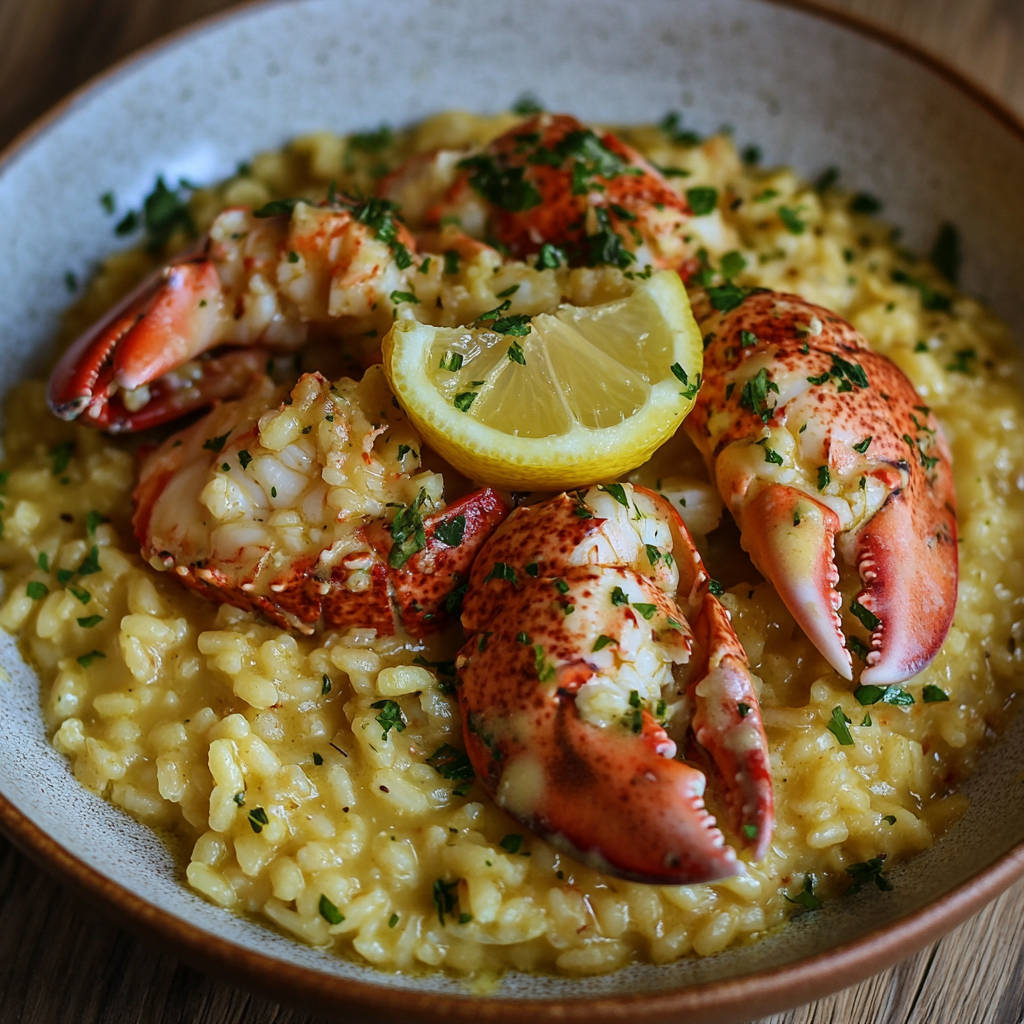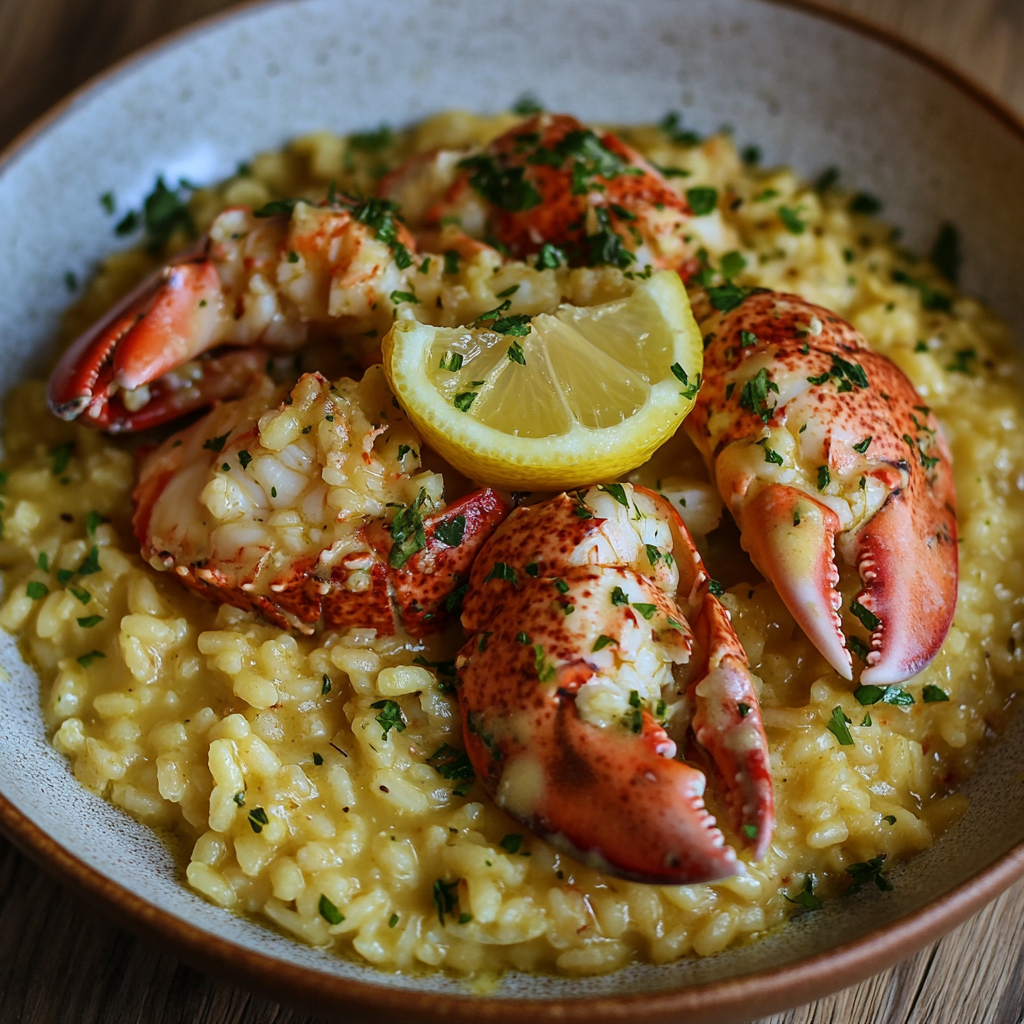Lemon Butter Lobster Risotto is the epitome of refined comfort food, combining the creamy, luxurious texture of arborio rice with the tender, delicate sweetness of lobster meat and the zesty brightness of lemon butter. This dish strikes the perfect balance between elegance and indulgence, ideal for special occasions or elevated weeknight dinners. Each bite delivers a harmony of flavors: rich, velvety risotto enhanced by the depth of seafood stock, lifted by citrusy notes and enriched with butter and parmesan for a truly decadent experience. Whether served as a main course or a lavish starter, Lemon Butter Lobster Risotto embodies the sophistication of fine dining with the warmth of a home-cooked meal.
The History of Lemon Butter Lobster Risotto
Risotto, a hallmark of Northern Italian cuisine, originated in the Lombardy region and dates back to the 16th century, traditionally made with short-grain rice varieties like arborio, carnaroli, or vialone nano. It evolved as a staple in Italian households due to its adaptability and the abundance of rice in the Po Valley. The creamy texture of risotto is achieved through slow cooking and constant stirring, which releases the rice’s starch. Lobster, on the other hand, was once considered a poor man’s food in coastal regions but transformed into a symbol of luxury and gourmet cuisine, especially in France and North America. The fusion of lobster with risotto likely emerged as chefs sought to elevate traditional Italian dishes by incorporating premium seafood. The addition of lemon butter adds a French-inspired twist, bringing freshness and brightness to balance the richness of the lobster and risotto. Today, Lemon Butter Lobster Risotto stands as a luxurious dish that reflects culinary refinement while honoring the rustic traditions from which it grew.
Ingredients Breakdown
Lobster: 1–2 lobster tails or about 1 cup cooked lobster meat, chopped into bite-sized pieces.
Rice: 1 cup arborio rice, known for its high starch content and ability to absorb liquid while maintaining a creamy texture.
Aromatics: 1 small shallot, finely diced; 2 garlic cloves, minced, to build a flavorful base.
Liquids: ½ cup dry white wine for deglazing and depth; 4 cups seafood stock (or a mix of chicken broth and clam juice) warmed and added gradually for ideal consistency.
Fats: 3 tablespoons unsalted butter (divided), plus 1 tablespoon olive oil to sauté aromatics; lemon butter sauce made with 2 tablespoons melted butter, 1 tablespoon lemon juice, and ½ teaspoon lemon zest.
Cheese: ½ cup freshly grated parmesan for creaminess and umami.
Garnish: Fresh parsley, chives, or microgreens; optional pinch of red pepper flakes for heat.
Seasoning: Salt and freshly ground black pepper to taste.
Step-by-Step Recipe
Step 1: Prepare the lobster by boiling or steaming lobster tails for 5–7 minutes until the meat is opaque, then remove from shells and chop. Alternatively, use pre-cooked lobster.
Step 2: In a saucepan, warm the seafood stock over low heat and keep it gently simmering.
Step 3: In a large skillet or wide saucepan, heat 1 tablespoon olive oil and 1 tablespoon butter over medium heat. Sauté the shallots for 2–3 minutes until translucent. Add minced garlic and cook for another 30 seconds until fragrant.
Step 4: Stir in the arborio rice and toast for 1–2 minutes until the edges of the grains become translucent.
Step 5: Pour in the white wine and stir continuously until it’s absorbed.
Step 6: Begin adding the warm stock one ladle at a time, stirring often. Allow each addition to absorb before adding the next. This process should take about 20–25 minutes.
Step 7: When the rice is al dente and the mixture is creamy, stir in the chopped lobster meat. Add the lemon zest, lemon juice, and remaining butter.
Step 8: Fold in the grated parmesan cheese and adjust seasoning with salt and pepper.
Step 9: Remove from heat and cover for 1–2 minutes to allow the flavors to meld.
Step 10: Serve immediately, garnished with fresh parsley, lemon wedges, and optional red pepper flakes for a subtle kick.
Tips for the Perfect Lemon Butter Lobster Risotto
Use high-quality lobster meat, either fresh or frozen, but always fully thawed and patted dry before adding. Toast the rice thoroughly before adding liquids—this adds a nutty depth and helps it retain its structure. Stir often but not constantly to avoid breaking the grains and to ensure even cooking. Always use warm stock to maintain a consistent cooking temperature and avoid shocking the rice. Add the lemon juice and zest at the end to preserve their fresh, bright flavors. For ultra-creamy texture, finish with an extra tablespoon of cold butter stirred in just before serving. Avoid overcooking the lobster by adding it at the end—this keeps it tender and succulent.
Variations and Customizations
Protein Swaps: Substitute lobster with shrimp, scallops, crab meat, or a mix of seafood for a different take.
Vegetarian Version: Replace seafood stock with vegetable broth and use grilled asparagus, mushrooms, or artichokes in place of lobster.
Herb Enhancements: Add fresh tarragon, dill, or basil for a twist on the traditional flavor profile.
Zesty Additions: Stir in a touch of crème fraîche or mascarpone for a tangy, ultra-creamy finish.
Spicy Kick: Add red pepper flakes, cayenne, or a dash of hot sauce to the lemon butter.
Wine-Free Option: Omit the white wine and replace with an equal amount of stock and a splash of apple cider vinegar or lemon juice.
Health Considerations and Nutritional Value
Lemon Butter Lobster Risotto is rich in protein, calcium, and omega-3 fatty acids from lobster and cheese, and offers antioxidants from garlic, shallots, and lemon. However, it’s also high in saturated fat, cholesterol, and carbohydrates due to butter, cheese, and arborio rice. For a lighter version, reduce butter and cheese, use low-sodium broth, and substitute some of the rice with riced cauliflower or farro. Whole-food ingredients like fresh herbs, lemon, and garlic add flavor without additional calories. Portion control is key for balancing its indulgent richness with a healthy meal plan, and pairing it with a light salad or steamed vegetables can add fiber and nutrients to the overall dish.
FAQ
Can I use frozen lobster? Yes, but ensure it’s fully thawed and drained before cooking to avoid excess moisture.
What rice works best? Arborio is ideal, but carnaroli or vialone nano can also be used for an even creamier texture.
Can I make this ahead? Risotto is best served fresh, but leftovers can be reheated with a splash of broth or cream to restore the texture.
Is there a non-alcoholic substitute for white wine? Yes, use extra broth with a splash of lemon juice or white wine vinegar.
How do I prevent overcooking the lobster? Add lobster meat toward the end, just long enough to warm it through.
What should I serve with this? A crisp green salad, roasted vegetables, or a glass of chilled white wine like Sauvignon Blanc or Chardonnay pairs beautifully.

Lemon Butter Lobster Risotto
Ingredients
Method
- Bring a large pot of salted water to a boil and add the lobster tails. Boil for 3–4 minutes, or until the shells turn a vibrant red.
- Remove the lobster from the water and allow it to cool slightly. Using kitchen shears, carefully cut open the shells and extract the meat. Chop the lobster into bite-sized pieces.
- In a skillet over medium heat, melt the butter and add the minced garlic. Sauté for about 30 seconds until fragrant. Add the chopped lobster meat, season with salt and pepper, and cook for 1–2 minutes. Finish with a drizzle of fresh lemon juice, then set aside.
- In a large skillet or saucepan, heat the olive oil and butter over medium heat. Add the minced shallot and garlic, cooking for about 2 minutes until softened and aromatic.
- Stir in the arborio rice and cook for an additional 1–2 minutes, just until the rice begins to look slightly translucent around the edges.
- Pour in the white rice vinegar and allow it to simmer until nearly all the liquid has been absorbed.
- Begin adding the warmed broth one ladle at a time, stirring often. Wait for the rice to absorb most of the liquid before adding more. Continue this gradual process for about 20 minutes, until the risotto reaches a creamy, tender consistency.
- Stir in the grated Parmesan cheese, optional heavy cream, lemon zest, salt, and pepper. Mix until the cheese has melted and the risotto is smooth and creamy.
- Gently fold in the sautéed lobster pieces to warm them through without overcooking.
- Plate the risotto, sprinkle with freshly chopped parsley, and serve immediately. For a complete meal, pair with a crisp green salad or a side of roasted asparagus.
